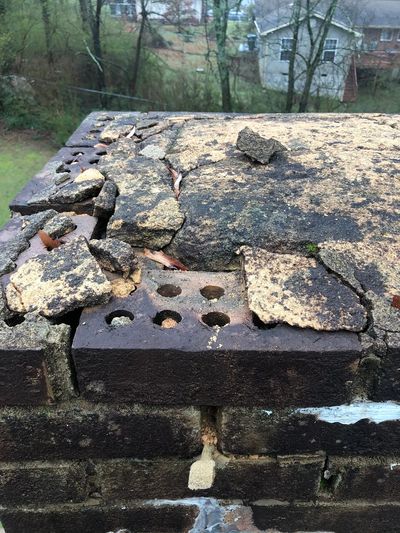Chimney Leaks

#1 The Simplest Cause of Chimney Leaking: Rain Going Straight In from the Top
Chimneys without chimney caps allow rain to fall straight down into them. A chimney cap makes sense to most people. Not only does it keep the rain out, but keeps birds, animals and debris out. The greatest value of the chimney cap is really keeping these out while allowing the smoke to escape.
To Fix
Call us to have a chimney cap put on. A professional will measure and fit your chimney with the correct size. And can outfit your chimney with chase covers, caps, shrouds,
multiflue caps, side mounted caps etc.
#2 Many Chimney Leaks are from Cracks in the Chimney Crown
The chimney crown is the cement part on top of the chimney. The bricks go up around the tile flue liners, but at the top you need something to stop the rain and snow from just falling in around the tiles. You can see that the very purpose of the chimney crown is to keep rain out. Cracks in the chimney crown can occur from shifting of the structure or from shrinkage dating back to the first day the crown was put on. When your crown has cracks, the water goes right through those cracks.
To Fix
How to fix a cracked crown depends upon how bad the damage is. Most crowns have small cracks. Even small ones need to be fixed because all big cracks started out as small ones. Water freezes and thaws in the cracks all winter long, year after year, forcing small cracks to eventually become big cracks. There are excellent crown coating materials such as Chimney Saver Crown Coat which cover the masonry and prevent small cracks from becoming a real problem.
Best to coat your crown now with Crown Coat and avoid the big hassle and expense later
#3 Chimneys Leaking From the Inside Out from Condensation
If the chimney was not lined with a properly sized flue liner.
To Fix
Gas fumes are very low temperature and have a lot of moisture in them. The fumes condensing on the inside of a too-large, too-cold old chimney, literally will soak the bricks and keep them moist all the time. A chimney liner of the correct size will solve this problem.
#4 Chimney Flashing Causes Leaks
The flashing is what keeps water from going into the place where the brick structure comes through the roof (or otherwise comes close to the roof.) There’s a fairly large gap between the bricks and the roof and water will pour through that hole if it’s not sealed up. Flashing is often aluminum that goes in between a couple bricks and bends to go on top of the shingles. Some sort of water proof “stuff” seals those spots. Though it’s far from the best choice, the “stuff” is often tar. In any event, flashing doesn’t last forever and the tar lasts even less time.
To Fix
There are better materials for sealing the flashing now. If you get a chimney sweep to fix your flashing, tell him you want Flash Seal by Saver Systems. (As you can see, I like Saver Systems products; but they just work well, so you can’t go wrong!) It seals better and lasts longer.
#5 Chimney Leaks Caused by Leaking Bricks
Bricks and mortar both pass water, and often lots of it. The problem here is the same as with the crown- the freezing and thawing all winter long with the resulting damage which causes leaks in the house.
You have probably heard of waterproofing a chimney, but you have to be careful about what waterproofing material to use. When water is absorbed into a brick or a mortar joint in the summer time, the water probably dries out after a while. The exceptions might be for a surface in the shade or on the side of the house where the sun never shines; those walls just stay wet. That water does try to escape by “falling” i.e. the water weight (or head pressure) carries it toward the ground where it forces its way out of the bricks either inside or outside of the house.
To Fix
If you apply a waterproofing material that physically blocks the pores of the brick or mortar, the water is trapped inside the brick. Some bricks actually get soggy, though it’s more likely that the water will just seep to the inside of the house. To the point, using silicone based water sealants may trap water and cause more damage than you started with. Use polysiloxane type waterproofing agents, such as Chimney Saver by Saver Systems.
This website uses cookies.
We use cookies to analyze website traffic and optimize your website experience. By accepting our use of cookies, your data will be aggregated with all other user data.